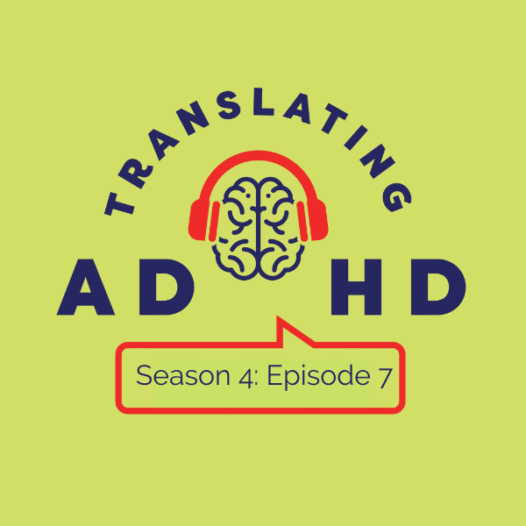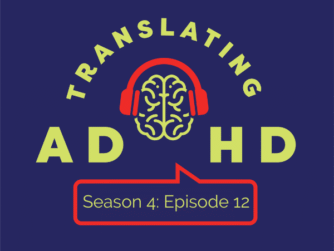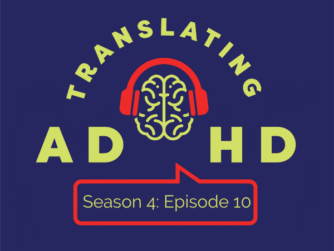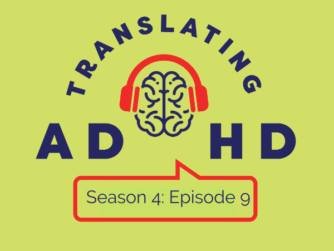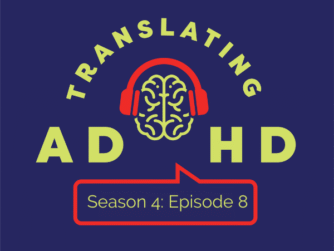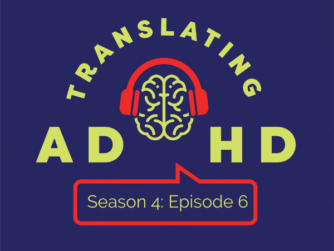In this episode, Asher and Dusty introduce and unpack a practical coaching tool—“yours, mine, and ours”—designed to help people with ADHD (and their partners or coworkers) distinguish which parts of a conflict or problem they truly own, which belong to someone else, and where there’s real opportunity to collaborate. Asher explains how the model prevents the common ADHD pattern of blame-sponge behavior (automatically assuming fault), restores perspective, and helps people decide whether they can co-create a solution or need to make a different choice (for example, stepping away from a job with an immovable boss).
The hosts use real coaching examples—two business partners with different ADHD presentations and a client who left a job after recognizing her struggles were her boss’s responsibility—to show how the model shifts conversations from reactive guilt to clearer agency. Lastly, the hosts discuss how the framework helps in marital situations, especially when ADHD intersects with an anxious partner, by promoting healthier communication, individual pause-and-reframe strategies, and clearer requests for support.
Episode links + resources:
For more of the Translating ADHD podcast:
- Episode Transcripts: visit TranslatingADHD.com and click on the episode
- Follow us on Twitter: @TranslatingADHD
- Visit the Website: TranslatingADHD.com
Episode Transcript:
[00:01:13] Asher: Hi, I’m Ash. [00:02:28] Dusty: And I’m Dusty. [00:03:25] Asher: And this is Translating ADHD. [00:08:20] Dusty: Don’t forget, on the 29th of October, I’m going to be doing a live coffee chat for patrons at 3 p.m. PST. So if you are a supporter of this podcast, come hang out with me. We can talk about your favorite Star Trek episodes. I’m curious to know which one is your guys’ favorite. You can ask me questions about ADHD or other things and I would love to meet y’all.So let’s do it!
[00:33:27] Asher: If you’d like to join in and you’re not yet a Patreon subscriber, you can visit the website www.translatingadhd.com and click on the Patreon tab. And for $5/month, you get access to this event and our other monthly live events, and to our podcast Discord server. [00:52:10] Dusty: So, Ash, what are we talking about today? [00:55:21] Asher: Dusty, today I want to revisit a model that I still use frequently in my own coaching called “yours, mine and ours”. When I pull this model out, it’s usually some sort of interpersonal dilemma, be it boss, subordinate, be it with a coworker, a friend, a spouse, a family member or an opportunity.It’s about distinguishing those of us with ADHD who are really prone to blame sponging because we’ve had this repeat experience of missing deadlines, not living up to expectations for getting and having things actually be our fault, having good intentions in relationships but not matching that good intention with action because of our ADHD and because of those repeat experiences over a lifetime, we kind of tend to default to things being our fault or our responsibility to fix. So, when someone else is upset with us, we can often just go to this sort of defensive place where we’re assuming that we’re at fault and that’s the place that we’re starting from. One of the things that this model helps us do is distinguish what’s mine and what’s not mine in this situation.
So when I’m working with a client on this, what we will start with is what’s yours and what’s not yours. What’s your stuff in this dilemma and what’s not your stuff in this dilemma. And where ours comes in is what, if anything, is the opportunity to co-create here, to come together, to work together, to have a better solution.
In some cases, the opportunity is none. In other cases, the opportunity is great. It just depends on the particular dilemma. I think the other thing that this model does really well is it helps reframe situations where we may not have the type of control that we would like to have in a situation. I’m actually going to start with an example that is about that.
I am working with two business partners right now. I’m working with them individually. We’ve done some collaborative coaching, and now we’re doing individual coaching because that’s what makes sense for where both of them are at, at this point. They both have ADHD, but they have completely different ADHD challenges.
One of the partners is actually pretty good at showing up on time and meeting deadlines. That’s not where her ADHD struggle lives, but her partner, that’s exactly what he struggles with. Meeting deadlines is a huge challenge for him, and that is what he and I are coaching about right now. So she shows up to our last coaching session with the topic of collaboration and what she’s really asking for, and I recognize this right away, particularly since in this instance, I’m coaching them both as she’s looking for him to have a different experience.
How can I show up differently so that he can have a different experience? Is she asking about now? That’s not how she’s framing it, but it’s something that I recognized up front and suggested to her. And then I immediately pulled out this “yours, mine and ours” model. Now, right now, for the two of them, there’s not much to be done, there is no “ours, because he’s trying to do his own work on his own with his own challenges.
He doesn’t know what support looks like from her right now, because we’re still in very early days of trying to have a different experience there. And so, interestingly enough, this helped us kind of pivot the conversation from how can I help him have a different experience when he’s the roadblock to the most important thing, what does it look like to have agency and choice with the way things are?
This is his stuff. This is something that I don’t have control over in this moment. So what does it look like for me to show up differently? And so what we came to is, number one, she still wants to ask for the collaboration. She still wants to kind of push for, “hey, do you think we can work on this project today? Do you think we can knock some of this out together and collaborate on this today?”
But the big difference maker there is if the answer is no for any reason, that is his stuff. Her opportunity in that moment is to detach from that because there’s nothing more for her to do. There’s nothing more that she can do in that moment to have a different outcome. It’s not within her control.
And so the language that we kind of came up with is if I can’t collaborate on the most important thing – so if the most important thing is collaborative and I can’t collaborate on the most important thing, then what? The other thing that this did is it allowed us to circle back and pick up a thread from the previous coaching conversation in which she was expressed the desire to do more intellectually challenging work, and to have more agency over what challenges she’s setting for herself, which is kind of leading to seeking out client work and projects where she can be the lead, where she can be the one in charge.
So it’s this sort of independent desire of this dilemma, but also an opportunity to pull on that thread and explore as a potential solution to this challenge that exists between these two partners.
[06:32:14] Dusty: This is really fascinating. And I’m curious how, because, I mean, this is a bit of a unique situation where you’ve got two clients that you’re coaching. So how does this apply when you’re just coaching one person or one half of a communication partnership? [06:46:07] Asher: Dusty, that’s a good question. And I would say, really, the only difference in this case is I didn’t need the client to give me context about the dilemma, because I already knew the context since I’ve worked with both of them, and since I know a lot about their working partnership. But in any other case, the model remains the same. It’s about examining what is the client’s stuff, what is not the client’s stuff, what are the opportunities to co-create or not?Another example, I coached a client through a job change. She left a job where after going through the “yours, mine and ours” model, she had this new awareness. She realized that most of the challenges that she was having at work, which she was attributing to ADHD – hence why she came to ADHD coaching – were not her stuff, they were her boss’ stuff and there was no opportunity for change there.
Based on what she knew about her boss in that relationship, there was no opportunity to have a better experience, to come together and co-create. This also comes up for my clients a lot when it comes to marital dilemmas and oftentimes marital dilemmas that do include ADHD.
So a spouse that is frustrated by ADHD behaviors, and in that case, oftentimes the spouse will join a coaching session or two if they are open to it, which then becomes the “ours”. But doing yours and mine is also really nice for my clients to be able to kind of distinguish that, yes, we’re having challenges, but those challenges aren’t necessarily all me and all ADHD.
Again, we can tend to blame sponge and in marriages, unfortunately, a lot of times ADHD can become the scapegoat for a number of things. So stepping back and getting a healthier perspective about what is actually ADHD and my stuff here, the stuff that I need to own, the stuff that I need to work on and create change around, but also what do I need from my spouse? How do I need my spouse to show up differently here?
A classic example of that is sort of the angry spouse, which can then throw an ADHD person into that defensive place, into your limbic system, into a place where problem solving isn’t possible. And so there’s an opportunity there for both people to show up differently.
[09:14:03] Dusty: I’m really fascinated by this and I’m wondering how you came up with it? Or where did the inspiration for this come from? Sorry. Is this something that came up in your own life or is it something that you just kind of noticed was a theme in all the clients you were coaching or both? [09:28:09] Asher: Dusty, that client story that I just told, I’ve told a longer version of that story on a previous episode of this podcast, but that client that ended up making the choice to leave her job, that was the session in which I came up with this model. It just seemed at the time it was something I tried because I was kind of hearing the challenges weren’t my clients, but she wasn’t seeing that.So this was me kind of on the fly. Let’s try this. Let’s try and break it down this way. And I think it started by me asking what’s your stuff and what’s not your stuff, right? So it’s not like I came up with “yours, mine and ours” right there in the moment: but, we had this interesting conversation about what was her stuff and what wasn’t her stuff and what opportunity or not existed for change there or not.
That conversation with that client sort of bore this model because the next time I ran into that situation with a client it was in a very different situation, it was a spouse situation. I brought that same language – let’s talk about and let’s really examine this. Let’s distinguish what’s your stuff here and what’s not your stuff here, and look at it from that perspective, because that helps us kind of get up above it, get out of the emotion of it and get curious and bypass that tendency to to take on the blame, to take on the faults.
[10:54:03] Dusty: Yeah. We talk about different coaching approaches, you know, we’ve kind of all been around the block, but I’ve never heard it put quite this way. I think it’s really useful because I certainly have a lot of clients who do exactly what you’re talking about. They take too much blame for stuff that isn’t theirs because, like you say, they’re just so used to being the person in the situation who’s wrong and assuming that they have to do all the fixing.But I think there is a piece here as well around agency, right? Like when you are feeling like you’re the person doing everything wrong and you’re messing everything up and everything’s on your shoulders. I think there’s also a sense of control that’s taken away from you, because now it’s just about you being reactive and responsive, and you’re constantly in this reactive fix mode, and you can lose some of that agency around, well, what do I want? Where do I have agency? Where do I have control? What’s my agenda? What action can I take that’s going to make me feel good and feel that I’m proactively helping myself, or showing up the way that I want to show up?
[12:12:09] Asher: Exactly Dusty. One pattern I do see in my coaching where this is really helpful, is the intersection of an ADHD spouse and an anxious spouse. Because an anxious spouse, particularly an anxious spouse, that maybe leans a little Type-A, you know, wants things to be done a certain way is kind of a linear thinker, can mean that the ADHD person’s inability to sort of follow along and do things the way that the anxious spouse would like them to be done can provoke an anxious cause.So an emotional, anxious response from the anxious spouse, doesn’t serve anyone.And in that situation, again, the ADHD spouse often feels at fault or the one to blame. This is all me. If I could just live up to my spouse’s expectations, this would stop happening.
But stepping back and examining that there’s two people communicating here. So if you’re coming at me angry and anxious, of course that’s going to provoke an emotional response.
I’ve had a couple of clients for whom they sort of recognize that their spouse has that anxious personality, and that it doesn’t show up all the time but just at certain times. And so part of the “what’s mine” becomes around I want to show up differently here. I want to have my own pause, disrupt and pivot where I don’t let this knock me down so many pegs, where I don’t let this affect me the way that I’ve let it affect me before, where I don’t let this become about my failure or my inability. I can kind of just separate and recognize that my spouse is having an anxious moment, but I don’t have to take what’s being said at face value.
And I can advocate for communicating differently in these situations. That’s where ours is. I can communicate, yes, my ADHD may be showing up and causing us challenges here, but this way of communicating about it doesn’t work for me. It doesn’t help us get to any sort of solution.
[14:27:14] Dusty: Damn, that’s powerful. The main thing for people listening at home, I hope, is just this idea that, if you are stuck in that cycle of always feeling like you’re wrong, of always feeling like you’re to blame if you’re caught in a cycle of feeling very reactive, that you always have to be cleaning up your messes – there’s a better way.And part of it is stepping back to do some examining like you’re saying. It’s hard to do that when you’re kind of moving too fast, right? And you are like, oh no, now there’s this, oh no, now there’s this. Because I think often when there’s fault, there’s also crisis, even if there’s not crisis, we will make there be crisis.
So I think the big takeaway for listeners here, Ash, is to to step back, to slow it down and to ask that question that you’re asking, what’s yours, what’s mine and what’s ours exactly.
[15:21:26] Asher: Dusty to take a pause and examine it differently is right. Because in that moment, we’re going to have an emotional response. We’re going to have that emotional response that wants to take what’s happening at face value, that wants to blame sponge, that wants to avoid or run and hide or make it go away. This is an opportunity to think through it differently.And the reason I like the example that I brought up at the front is sometimes it’s also an opportunity to think differently about, okay, if there is no ours, then what does being at choice look like in this situation? And that very first client that I did this with – that’s what we got to. If this is true, if there is no opportunity to have a different experience with your boss and that your boss is the cause of a lot of your dilemmas and stress and strife at work, then what does it look like to be a choice here? And that was when she was able to make the decision to leave.
[16:31:05] Dusty: Well, that is some powerful stuff, and I’m glad you taught me that, because I can already think of a few clients for whom this would be a really useful model. So thank you. [16:39:29] Asher: Nice, nice. I love that you’re going to take this into your own coaching, and perhaps someday we will revisit it again with some examples from your client work. But until then, I think this is a good time for us to wrap for today. I’m Ash. [16:53:04] Dusty: And I’m Dusty.[16:54:01] Asher: And this is the Translating ADHD podcast. Thanks for listening.

